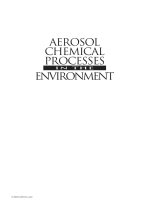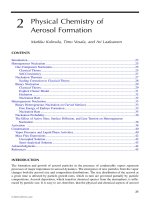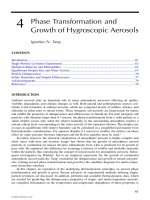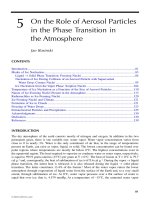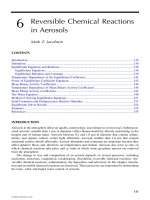Rainfall runoff processes in tropical urban environments
Bạn đang xem bản rút gọn của tài liệu. Xem và tải ngay bản đầy đủ của tài liệu tại đây (9.94 MB, 209 trang )
RAINFALL-RUNOFF PROCESSES IN TROPICAL URBAN
ENVIRONMENTS
ALI MESHGI
NATIONAL UNIVERSITY OF SINGAPORE
2015
RAINFALL-RUNOFF PROCESSES IN TROPICAL URBAN
ENVIRONMENTS
ALI MESHGI
(MSc, Shiraz University)
A THESIS SUBMITTED
FOR THE DEGREE OF DOCTOR OF PHILOSOPHY
DEPARTMENT OF CIVIL AND ENVIRONMENTAL ENGINEERING
NATIONAL UNIVERSITY OF SINGAPORE
2015
iv
v
DECLARATION
I hereby declare that this thesis is my original work and it has been written by me its
entirety.
I have duly acknowledged all the sources of information which have been used in the
thesis.
This thesis has also not been submitted for any degree in any university previously.
ALI MESHGI
15 January 2015
vi
vii
T
This thesis is dedicated to my lovely wife
Shila who has supported me by all
means during my PhD stud
y.
viii
ix
ACKNOWLEDGMENTS
I would like to express my gratitude to all those who have helped me to
complete my PhD studies at NUS. I am deeply grateful to my supervisors,
Assoc. Prof Vladan Babovic from Department of Civil and Environmental
Engineering, National University of Singapore and Assist. Prof May Chui
from Department of Civil Engineering, The University of Hong Kong, whose
knowledge, experience, encouragement, support, and suggestions helped me
throughout the course of my graduate studies. I also would like to express my
gratitude to Dr. Petra Schmitter, whose constant guidance, support, and
suggestions during my PhD study were significantly helpful. I also wish to
thank Singapore Delft Water Alliance (SDWA) for giving me the scholarship
and financial support for my PhD study.
I also would like to express my sincere thanks to Dr. Abhay Anand for his
warm supports throughout the duration of my research. I also would like to
thank Ms. Noor Azizah Bte Aziz and Mr. Bergenwall Bjorn Allan Joakim for
their assistance in field study and laboratory testing.
I would like to thank my PhD colleagues, Abhay, Alam, Albert, Jayashree,
Kalyan, Nishtha and Serene for their kind supports. I also thank all of my
colleagues in SDWA and NUSDeltares Sally, Joost, SK, Jingjie, Jair, Aurelie,
Gerard, Umid, Sheela, Desmond, Wang Xuan, Stephane, Ivy, Saedah and
many others for their warm supports and kind encouragement.
x
Lastly, I also gratefully thank my lovely wife, parents, sister and my son
for their love, warm supports and constant encouragement.
xi
Table of Contents
CHAPTER 1
INTRODUCTION 1
1.1 Backgrounds and Motivations 1
1.2 Objectives 8
1.3 Outline 10
CHAPTER 2 LITERATURE REVIEW 13
2.1 Introduction 13
2.2 Baseflow Separation Techniques 13
2.3 Rainfall-Runoff Modelling 17
2.3.1 Physically-based models 17
2.3.2 System theoretic models 19
2.4 The Effects of Land Use on Rainfall-Runoff Processes 22
2.5 Assessment of Soil Hydraulic Properties and Infiltration Rate 25
2.6 Discussion 28
CHAPTER 3 DESCRIPTION OF THE STUDY SITES, MONITORING
PROGRAMME AND FIELD STUDIES 33
3.1 Introduction 33
3.2 Kent Ridge Catchment, Singapore 33
3.2.1 Monitoring Program 39
3.2.2 Tension infiltrometer measurements 41
3.3 Beaver River Basin, US 44
xii
CHAPTER 4
PROCESSING AND ANALYSIS OF EXPERIMENTAL DATA 49
4.1 Introduction 49
4.2 Stage–Discharge Relationships in Discharge Monitoring Stations 50
4.3 Discharge, Rainfall and Groundwater Data Processing 54
4.4 Soil Particle Size Analysis 57
4.5 Analyzing Tension Infiltrometer Data 60
4.5.1 Inverse Modeling 60
4.5.2 Estimating Soil hydraulic properties 61
4.5.3 Further investigation on analyzing tension infiltrometer data 64
CHAPTER 5 DEVELOPMENT OF AN EMPIRICAL METHOD FOR
APPROXIMATING STREAM BASEFLOW TIME SERIES 85
5.1 Introduction 85
5.2 Numerical Modeling 86
5.3 Genetic Programing 94
5.4 Generalization of the Empirical Equation 99
5.5 Recursive Digital Filters 100
5.6 Statistical Tests 101
5.7 Results and Discussion 103
5.7.1 Simulating Baseflow Time Series in Kent Ridge Catchment Using
HYDRUS-3D 103
5.7.2 Approximating Baseflow Timeseries in Kent Ridge Catchment
105
xiii
5.7.3
Generalization of the Empirical Equation 110
5.7.4 Evaluation of the Generalized Equation in Beaver River Basin 115
5.8 Summary and Conclusion 118
CHAPTER 6 DEVELOPMENT OF A MODULAR MODEL FOR THE
SIMULATION OF STREAMFLOW TIME SERIES 121
6.1 Introduction 121
6.2 Approximating Quickflow Time Series Using Genetic
Programming 122
6.3 Generalization of Modular Model 125
6.4 Statistical Tests of Accuracy 127
6.5 Results and Discussion 129
6.5.1 Approximating Quickflow Time Series Using Genetic
Programming 129
6.5.2 Generalization of Modular Model 134
6.6 Summary and Conclusion 139
CHAPTER 7 QUANTIFICATION OF LAND-USE CONTRIBUTIONS TOWARDS
HYDROGRAPH FLOW COMPONENTS 141
7.1 Introduction 141
7.2 Quantification of Quickflow Contributions from Specific Land
Uses 142
7.2.1 Clustering Analysis 142
7.2.2 Land use specific runoff coefficient 144
xiv
7.2.3
Estimating total contribution of different land use types towards
the quickflow component 146
7.3 Results and Discussion 147
7.3.1 Quantifying Quickflow Contributions from Different Land Uses
147
7.3.2 Average runoff coefficients at catchment scale 155
7.3.3 baseflow contributions at catchment scale 160
7.4 Summary and Conclusion 161
CHAPTER 8 CONCLUSIONS AND RECOMMENDATIONS FOR FUTURE
RESEARCH WORK 163
8.1 Conclusions 163
8.1.1 Development of a modular physically interpretable model for the
simulation of streamflow time series, consisting of two sub-
models (i.e. baseflow and quickflow) 164
8.1.2 Enhancement of our understanding on contributions from different
land uses towards hydrograph flow components using the modular
model and optimization techniques 168
8.2 Recommendations for Future Work 170
8.2.1 Modeling of Streamflow under the Effects of Climate Change
Using a Hybrid Model 170
8.2.2 Runoff Generation Mechanism at Different Spatial Scales 171
8.2.3 Enhancement of water resources management in tropical urban
environments 172
xv
REFERENCES ……………………………………………………………………… 173
LIST OF PUBLICATIONS 181
xvi
xvii
Summary
Increasing global urbanization has severely altered the hydrological cycle resulting
in the decrease of pervious areas, infiltration and therefore the lateral sub-surface
component during rainfall events. Consequently this lead to increasing peak
discharges in the urban drainage infrastructure. This call for a better understanding of
rainfall-runoff processes in urbanized areas especially with regards to the
contributions of specific land use types towards surface and sub-surface flow.
However, this knowledge in tropical urban environments is limited. Therefore, the
main objective of this research is to better understand the hydrological rainfall-runoff
processes in an urban tropical system through a deeper insight into hydrograph flow
components and runoff response of specific land use types. This study used genetic
programming to establish a physically interpretable modular model consisting of two
sub-models to simulate the two hydrograph flow components of baseflow and
quickflow. Furthermore it used the modular model to predict the events as well as
time series of both flow components and optimization techniques to estimate the
contributions of various land use types (i.e. impervious, steep grassland, grassland on
mild slope, mixed grasses and trees and relatively natural vegetation) towards
baseflow and quickflow in tropical urban systems. A tropical urban catchment in
Singapore was chosen to setup a monitoring network for this study. This catchment
contains the main land uses (e.g. impervious, grassland, relatively natural vegetation)
as well as the main soil types (e.g. loamy sand, clay loam, silt clay, sandy loam) of
Singapore. Therefore, understanding the triggers behind rainfall-runoff processes as
well as their behaviour at this catchment yields valuable information for tropical
urbanized cities such as Singapore.
The results demonstrated the successful prediction of streamflow as well as
hydrograph flow components using the modular model developed in this study. The
relationship between the input variables in the model (i.e. meteorological data and
catchment initial conditions) and its overall structure can be explained in terms of
catchment hydrological processes. Therefore, the model is a partial greying of what is
often a black-box approach in catchment modelling and has strong extrapolation
xviii
capability. The modular model was further modified into a generalized structure and
was validated on a large vegetation-dominated basin located in the US.
The events as well as time series predictions of both flow components from the
modular model were then used to estimate the effect of various land uses towards
hydrograph flow components through robust optimization techniques in Singapore
Catchment. The results showed that the sub-catchment containing the highest portion
of impervious surfaces (40% of the total area) contributed the least towards the
baseflow (6.3%) while the sub-catchment covered by 87% of relatively natural
vegetation contributed the most (34.9%). The results also indicated that the average
runoff coefficient of different types of land use decreased according to: impervious
(0.8), grass on steep slope (0.56), grass on mild slope (0.48), mixed grasses and trees
(0.42) and relatively natural vegetation (0.12). The results also suggested that runoff
coefficients differ significantly among land uses for all rainfall events.
The outcomes of this study are new methodologies which can yield better insights
into the rainfall-runoff processes and helps for better understanding of runoff
generation mechanisms in tropical urban environments. This understanding contains
valuable information with regards to a physical understanding of rainfall-runoff
behaviour when designing appropriate water management infrastructure in tropical
megacities. This understanding would also be essential for water resources
management and the sustainable development of water resources particularly where
communities are dependent on water sources that are more vulnerable to inter-annual
fluctuations in precipitation.
xix
List of Tables
Table 3.1: Drainage areas of the discharge monitoring stations within the Kent Ridge
Catchment with their control structure type 41
Table 3.2: Relative distribution of land uses for each of sub-catchments within the Kent Ridge
Catchment 41
Table 4.1 : Statistical feature of the discharge monitoring data for the selected events 55
Table 4.2 : Statistical feature of the groundwater level monitoring data 57
Table 4.3: Soil hydraulic parameters of the van Genuchten functions (van genuchten, 1980)
for six soil textural classes of the USDA chosen according to Carsel and Parrish
(1988) 67
Table 4.4: Soil hydraulic parameters in the Kent Ridge Catchment, Singapore, estimated from
numerical inversion using field measurements 72
Table 4.5: Maximum slope at which accurate hydraulic property can be estimated using 2D
approximation for different soil types 78
Table 4.6: Maximum slope at different initial water contents for different soil types at which
accurate hydraulic property can be estimated using 2D approximation 81
Table 5.1: Definition of terminal set parameters 98
Table 5.2 : An overview of the evolutionary algorithm setup 98
Table 5.3: Estimated hydraulic parameters based on inverse modeling in HYDRUS-2D 104
Table 5.4: Error functions associated with observed and simulated pressure heads at BH1and
BH2 105
Table 5.5: Error criteria between baseflow time series simulated by HYDRUS-3D and the
empirical equation 107
Table 5.6 : Soil hydraulic parameters of the van Genuchten functions (van genuchten, 1980)
for five soil textural classes of the USDA chosen according to Carsel and Parrish
(1988) 108
Table 5.7 : Main characteristics of selected events observed at Kent Ridge Catchment,
Singapore 111
Table 5.8 : Estimation of lag time (k) in empirical equation from average of groundwater table
depth (m) in Singapore catchment and different soil types 113
Table 6.1 : Main characteristics of selected events observed at Kent Ridge Catchment,
Singapore 124
xx
Table 6.2: Parameter settings of algorithms 129
Table 6.3 : Error criteria between observed quickflow time series and those estimated by the
empirical equation in Kent Ridge catchment, Singapore 130
Table 6.4 : Error criteria between observed streamflow time series and those estimated by the
modular model in Beaver River Basin, US 138
Table 7.1: Statistical feature of the rainfall events 144
Table 7.2: Error criteria between observed quickflow time series and those estimated by runoff
module of modular model 148
Table 7.3: Average quickflow contribution and error criteria of each land use within clusters
and sub-clusters 149
xxi
List of Figures
Figure 1.1: Schematic illustration of the processes involved in the runoff generation(Tarboton,
2003) 2
Figure 1.2: General structure of a modular model 7
Figure 1.3: Unit models for simulating streamflow in a modular model 8
Figure 3.1 Location of Kent Ridge Catchment, Singapore, and its respective topography,
monitoring stations, sub-catchments and drainage infrastructure 35
Figure 3.2: Land use map of Kent Ridge Catchment, Singapore 37
Figure 3.3: Land use types of Kent Ridge Catchment including a) grass on mild slope, b) grass
on steep slope, c) mixed grasses and trees and d) relatively natural vegetation 38
Figure 3.4: Types of control structure for streamflow monitoring stations within Kent Ridge
Catchment, Singapore 40
Figure 3.5: Measuring of tension infiltrometer data 42
Figure 3.6: Location of Beaver River Basin, Rhode Island, US (National Geographic, 2012)
with DEM (Rhode Island Digital Atlas, 2014), monitoring stations and stream
network 46
Figure 3.7: Pervious and impervious areas in the Beaver River basin 47
Figure 4.1: Stage-discharge rating curves in discharge monitoring stations within the Kent
Ridge Catchment 53
Figure 4.2: An example of a monitoring well 56
Figure 4.3: Standard USDA soil texture triangle 58
Figure 4.4: Soil map of Kent Ridge Catchment, Singapore, with the locations of tension
infiltrometer experiments 59
Figure 4.5: Measured and optimized cumulative infiltration curves for a tension disc
infiltrometer experiment 62
Figure 4.6: Water retention curve obtained through numerical inversion of the field-measured
tension disk infiltrometer data 63
Figure 4.7: Modeling domain and boundary conditions at 20-degree land slope in HYDRUS
3D 68
Figure 4.8: Estimated hydraulic conductivities of loamy sand 1 and silt loam at different
slopes by inversing field experimental data 73
xxii
Figure 4.9: Cumulative infiltration into loamy sand and silt loam at various slopes obtained
from HYDRUS 3D simulations with same initial pressure head (-100 cm) 76
Figure 4.10: Estimated hydraulic conductivities of loamy sand and silt loam at different slopes
by inversing the simulated infiltrometer data 77
Figure 4.11: Water content under the tension infiltrometer disk at the end of the simulation at
a 20-degree slope 78
Figure 4.12 : Effect of initial water content on estimated hydraulic conductivities on
horizontal surface 82
Figure 5.1 : Location of selected sub-catchment for numerical modeling in HYDRUS3D 88
Figure 5.2 : Selected sub-catchment for numerical modeling in HYDRUS3D in Kent Ridge
Catchment, Singapore with monitoring stations, drainage network and DEM 89
Figure 5.3 : Finite element mesh of Kent Ridge Catchment, Singapore in HYDRUS-3D 90
Figure 5.4 : An example of a function tree used in GP representing the expression (p+v)*z
where ‘+’ and ‘*’ are inner nodes while p, v, and z represents terminal nodes
(Babovic and Keijzer, 2000) 96
Figure 5.5 : Two function trees in the parent models before and after the crossover and
mutation operation (Hong and Bhamidimarri, 2003) 96
Figure 5.6: The flowchart of the main steps in GP computation 97
Figure 5.7: Observed and simulated pressure heads at BH1 and BH2 in Kent Ridge
Catchment, Singapore which are respectively 180 and 90 m away from the
discharge measurement station 104
Figure 5.8: Comparison between baseflow estimated by the empirical equation and HYDRUS-
3D in Kent Ridge Catchment, Singapore 106
Figure 5.9 : Baseflow filter results based on daily river flow series of Beaver River, US from
1/1/1990 until 31/08/2013 116
Figure 5.10 : Comparison between baseflow estimated by WETSPRO and the generalized
empirical equation in a) Kent Ridge Catchment, Singapore and b) Beaver River
Basin, US 117
Figure 6.1: The flow chart of the proposed hybrid GA (GA-IPA algorithm) 128
Figure 6.2 : Scatter plot between observed streamflow and those estimated by modular model
at Station E which situates at catchment outlet in Kent Ridge Catchment,
Singapore 132
Figure 6.3 : Separation of observed streamflow data into its respective flow components using
modular model for six selected rainfall events as listed in Table 6.1 Kent Ridge
Catchment, Singapore 133
xxiii
Figure 6.4 : Sensitivity analysis of a) normalized pressure head and b) total rainfall, on
estimated quickflow for low (8 mm/h) and high (88 mm/h) rainfall intensities . 135
Figure 6.5 : Scatter plot between observed streamflow and those estimated by the modular
model in Beaver River Basin, US 138
Figure 7.1: Normalized variation in runoff coefficients (with respect to their minimum value
within each land use) of different land uses from Cluster-I/Sub-Cluster-1 to
Cluster-IV/Sub-Cluster-3 (grey bars represents the expected range of variability
of the median) 152
Figure 7.2: The Rainfall Intensity-Duration Frequency curves established for Singapore by
Public Utilities Board (PUB) (Code of Practice-Drainage Design and
Considerations, 2011) 154
Figure 7.3 : Average runoff coefficient within the clusters and sub-clusters for each discharge
monitoring station within Kent Ridge Catchment, Singapore 156
Figure 7.4 : Total land use specific quickflow contributions towards Station E from September
2011 until August 2012 for: a) absolute amount basis and b) equivalent area basis
159
Figure 7.5: The effect of land-cover transformation from pervious surfaces to impervious ones
on total quickflow 159
Figure 7.6 : Average contribution (%) of baseflow and quickflow from 150 rainfall events
towards the discharge measured at sub-catchment (Stations A-D) and catchment
(Station E) level 161
xxiv
xxv
List of Nomenclature
Chapter 4
Q
Discharge
ܥ
Discharge coefficient
g
gravitational acceleration
ߠ
Angle of V-notch
h
Water depth
ܥ
ଵ
Discharge coefficient for a V-notch weir
݄
ଵ
Water depth above V-notch
ܥ
ଶ
Discharge coefficient for the overlapping portion of the V-
notch and Rectangular weirs
݄
ଶ
Depth of the V-notch portion
ܥ
ଷ
Discharge coefficient for a Rectangular weir
L
Combined length of the horizontal sections
ܾ
The effective weir crest width
݄
The effective height above weir crest
ܪ
Energy head
ܾ
Bottom width of trapezoid shape
ݖ
The horizontal component of the side slopes of the
trapezoid
ݕ
Critical depth in the flume throat
ߠ
The volumetric water content
ܵ
Sink term
ݔ
The spatial coordinates
ܭ
Components of a dimensionless anisotropy tensor
h
Pressure head
K
Unsaturated hydraulic conductivity
ୱ
Saturated hydraulic conductivity
୰
Relative hydraulic conductivity
t
Time
ܵ
The effective fluid saturation
Ʌ
୰
Residual water content
Ʌ
ୱ
Saturated water content
Pore-connectivity parameter
Ƚ
Empirical shape parameter
Ʉ
Empirical shape parameter


